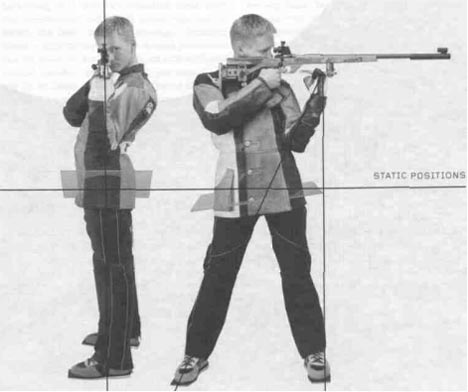
WHEN THE STATICS ARE CORRECT, THE RIFLE CAN BE HELD WITHOUT
STRENGTH. THE GUN IS STEADY AND CAN BE ACCURATELY FIRED. THE
STATICS MUST BE BALANCED BE FORE THE SERIES BEGINS, ES-PECIALLY
DURING THE COMPETITION.
Beginners usually make rapid progress. The scores rise
unexpect-edly fast. At some point, this rise slows down, and
despite all efforts, the results stagnate. At that point,
you either have to set-tle for the end of your ascent or
finally have to start working on the quality of your
shooting.
Whoever trains a lot the wrong way does not progress.
Whoever constantly repeats flaws in the shooting position
will always grapple with the same problems. It is therefore
necessary to understand the basic principles of the shooting
technique and to consistently practice them in training.
This doesn't take more time but does bring the added,
crucial points. Hard work must be go hand in hand with the
appropriate knowledge so that the ultimate result will be
correct.
STANDING SHOOTING POSITION:
THE STATICS.
In a house, the walls and beams provide for stability.
Horizontal elements, like the ceiling or roof, are supported
by girders. In the stand-ing shooting position, these same
principles lead to success. The parts of the body are
arranged as vertically as possible. The hori-zontally held
rifle is supported by an upright column that is stabilized
by a diagonal girder. The actual weight is assumed by the
bones that carry it with practically no strain due to their
sturdiness. Finely measured doses of muscular strength is
enough to stabilize the supporting framework.
These rough principles are comprehensible when viewed from
the side. Even faulty shooting positions comply with these
basic principles, since match guns, which are downright
heavy, would otherwise be nearly impossible to control.
Violations of the nature of statics are found in details.
If, for example, only 90% of the rifle weight is carried by
the skeleton, the remaining 10% must be supported by
muscular exertion. Strained muscles however give rise to
subtle movements which in turn cause the gun to sway. A
shooting position therefore only comes to rest to the extent
that the needed strength can be neutralized. The use and
opti-mization of statics are therefore a basic re-quirement
for steady holding.
|
 |
TEST AND TRAINING
Check whether your shooting position is stati-cally correct
by consciously relaxing various muscle groups. To do this,
lower your glance in the shooting position and breathe
calmly from the stomach. Afterwards, concentrate on your
left arm and left hand. Try to relax your hand, lower arm
and upper arm. Should you feel that your wrist is somewhat
buckled, you can over-come this weak point by shifting your
bones. A slight turn of the hand is enough to restore its
sturdiness. With this simple method, all parts of the body
can be checked and correct-ed one by one. This is strenuous
at first be-cause it is uncustomary. Through methodical
repetition, this procedure will soon become second nature to
you. If you are dedicated to this theme, you will train the
statics of your shooting position every time you shoot. You
should briefly check your statics before each shot, since
minor errors increase swaying considerably.
Shooters of caliber practically test their statics
unconsciously. The orrection of flaws among "better
shooters" can be recognized by the minor ovements they make
after each shot and when they take aim for the next shot.
What looks like nervous fidgeting turns out, upon closer
observation, to be repeated corrections of statics and
balance.
DURING COMPETITION
The danger of neglecting statics and starting right away
with the pursuit of tens is especially great at a
championship. Since we are also tense under stress, the
swaying is sometimes enormous.
That's why the following holds true especially during
competition: If you carefully bal-ance your statics and
equilibrium first, then your rifle will be steady and your
hits will be exact. And don't forget to do this before every
shot!
Heinz Reinkemeier
Copyright ©1998-2001.
ISSF International Shooting Sport Federation. All rights
reserved

Next Part |
|
|
|
|